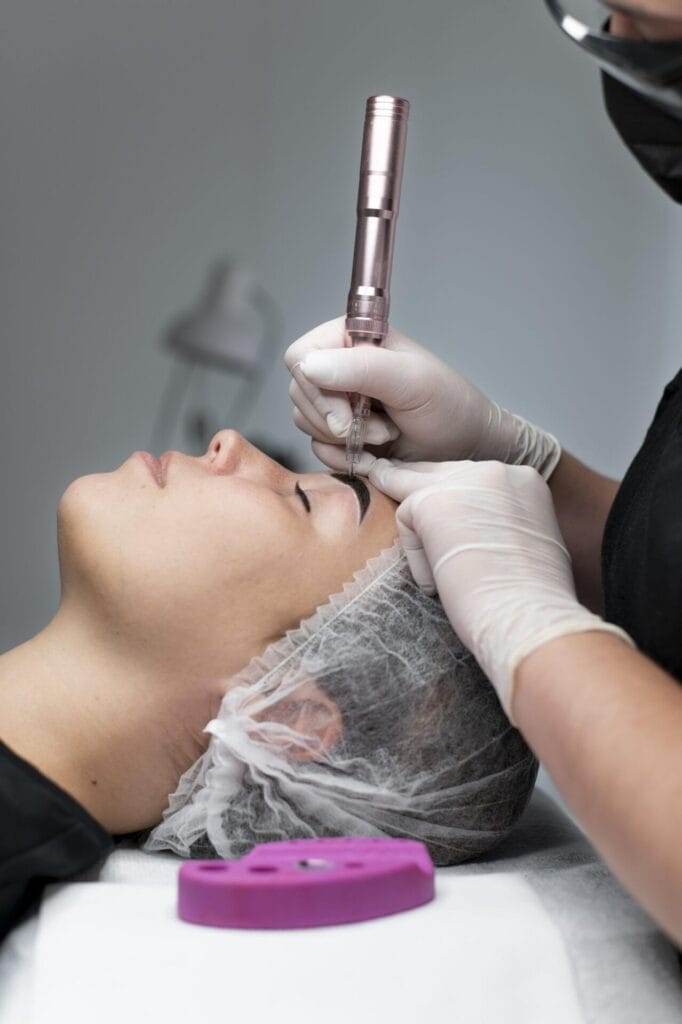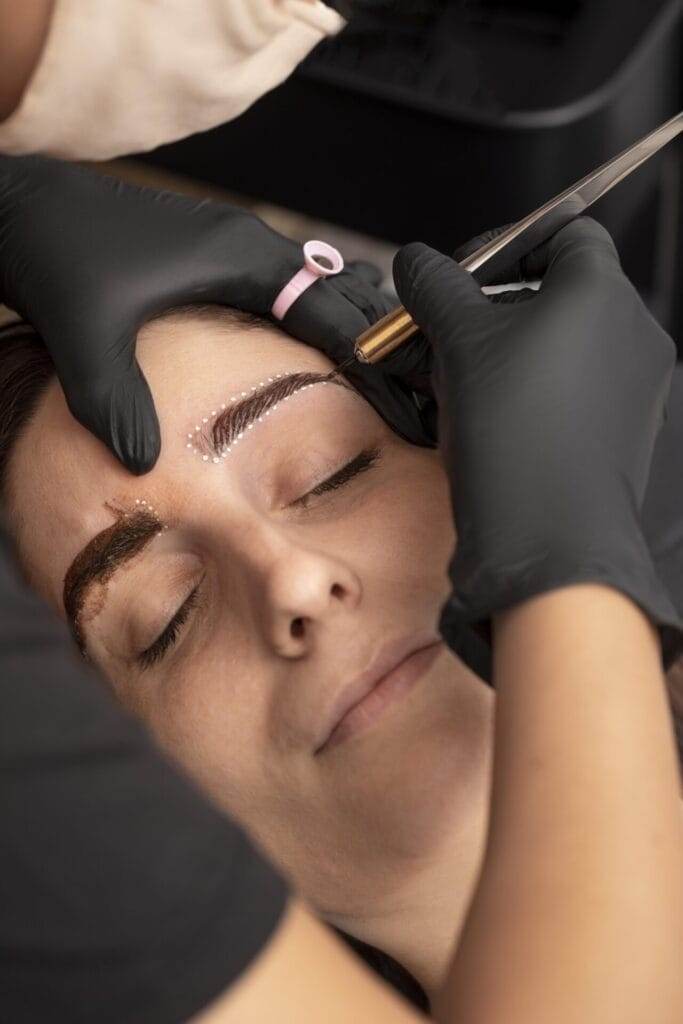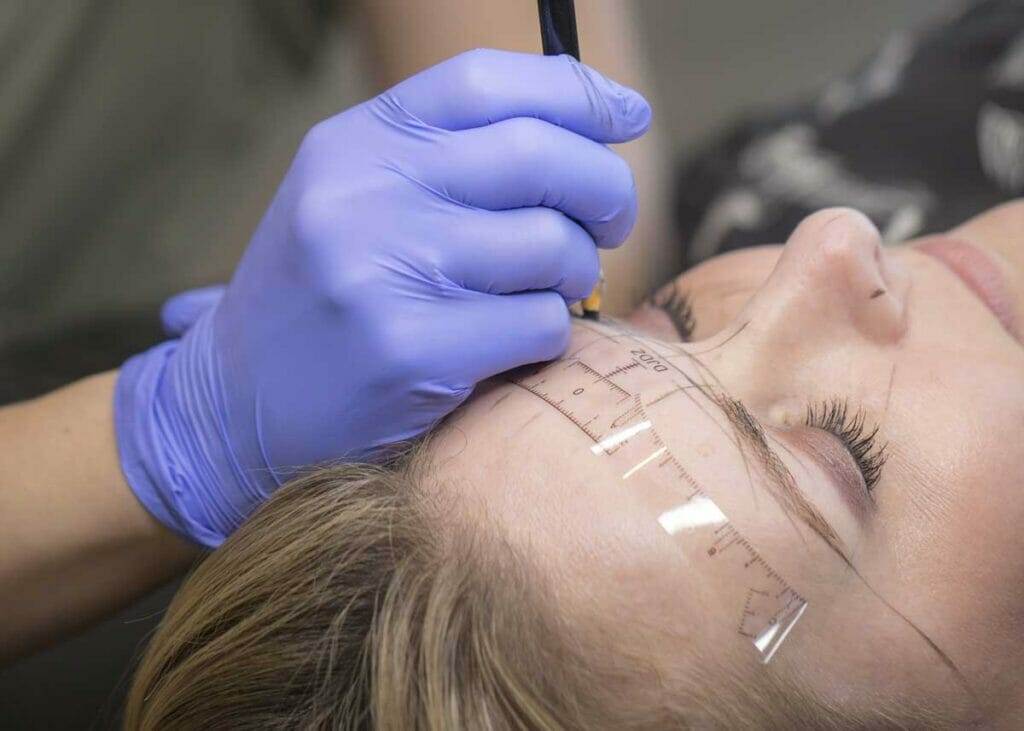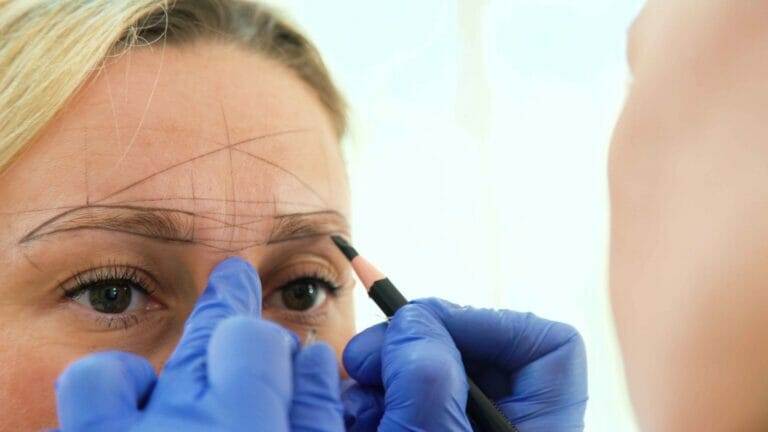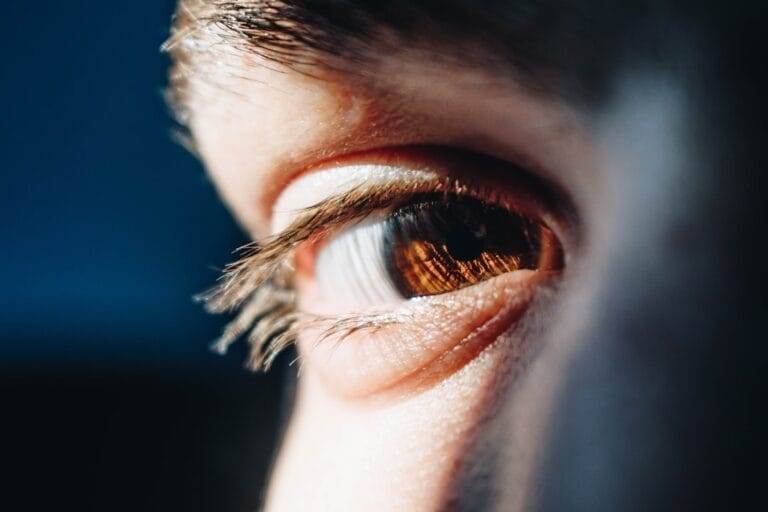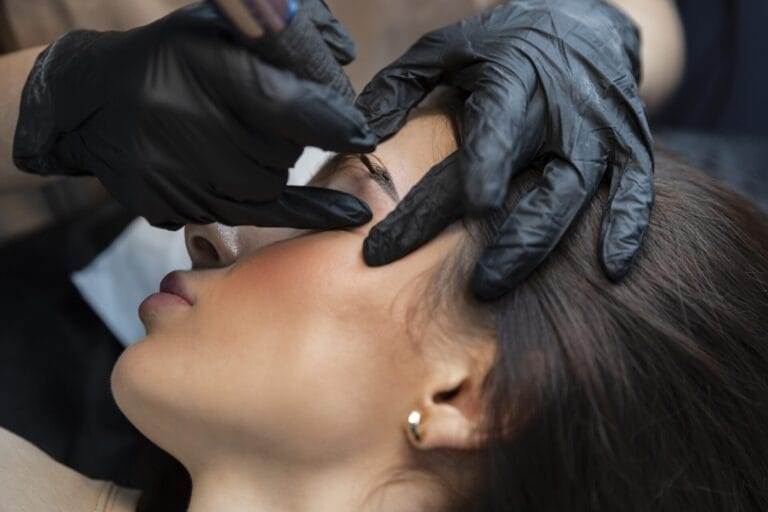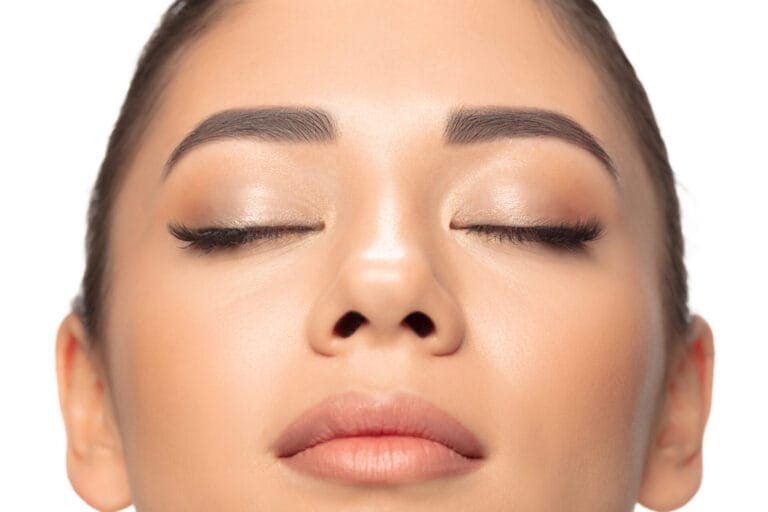Microblading is a semi-permanent cosmetic procedure that involves the use of a handheld tool to create hair-like strokes on the eyebrows. It is a popular technique for enhancing and reshaping eyebrows, giving them a fuller and more defined appearance. Unlike traditional eyebrow tattooing, which uses a machine and ink to create a solid color, microblading mimics the look of natural eyebrow hairs, resulting in a more realistic and natural-looking brow.
The process of microblading begins with a consultation, where the client discusses their desired brow shape and style with the microblading artist. The artist will then map out the brow shape, taking into consideration the client’s facial features and bone structure. Once the shape is agreed upon, the artist will numb the brow area using a topical anesthetic to minimize any discomfort during the procedure. The artist will then use a handheld tool with tiny needles to create small incisions in the skin and deposit pigment into the brows. The entire process typically takes about two hours to complete.
Benefits of Microblading: Why it’s the Perfect Solution for Perfect Brows
One of the main benefits of microblading is that it saves time and effort in your daily makeup routine. With microbladed brows, you no longer have to spend time filling in your eyebrows with pencils or powders every morning. Your brows will already be perfectly shaped and defined, saving you precious minutes in your beauty routine.
Another benefit of microblading is that it creates a natural-looking brow. The hair-like strokes created during the procedure mimic the look of real eyebrow hairs, resulting in a more realistic and natural appearance. This is especially beneficial for those who have sparse or thinning eyebrows, as microblading can help fill in gaps and create the illusion of fuller brows.
Microblading also offers long-lasting results. While the pigment does fade over time, the results can last anywhere from one to three years, depending on factors such as skin type and lifestyle. This means that you can enjoy beautiful brows for an extended period of time without the need for frequent touch-ups.
Furthermore, microblading is customizable to individual preferences. During the consultation, you can discuss your desired brow shape, color, and style with the microblading artist. They will work with you to create a look that complements your facial features and enhances your natural beauty. Whether you prefer a bold and dramatic brow or a more subtle and natural look, microblading can be tailored to your specific preferences.
Step One: Consultation and Choosing the Right Brow Shape
The first step in the microblading process is the consultation. This is an important step as it allows you to discuss your desired brow shape and style with the microblading artist. During the consultation, the artist will assess your facial features and bone structure to determine the most flattering brow shape for you.
When choosing the right brow shape, there are several factors to consider. Firstly, your face shape plays a role in determining the ideal brow shape. For example, those with a round face may benefit from a more arched brow to create the illusion of length and lift. On the other hand, those with a square face may benefit from a softer, more rounded brow shape to balance out their features.
Additionally, your natural eyebrow shape and hair growth pattern should also be taken into consideration. The microblading artist will work with your existing brows to enhance their shape and fill in any gaps or sparse areas. It is important to communicate your preferences and concerns with the artist during this step to ensure that you are both on the same page.
Step Two: Numbing and Preparing the Brow Area
To minimize any discomfort during the microblading process, a topical anesthetic is applied to the brow area. This numbing process helps to ensure a more comfortable experience for the client. The anesthetic is typically left on for about 20-30 minutes to allow it to take effect.
Once the brow area is numb, the artist will prepare the skin for the microblading process. This involves cleansing the brow area to remove any oils or debris that may interfere with the procedure. The artist will also apply a barrier cream or gel to protect the surrounding skin from the pigment.
Step Three: Mapping and Drawing on the Brows
Before the microblading begins, the artist will map out the brow shape using a measuring tool and a brow pencil. This step is crucial in ensuring symmetry and balance in the final result. The artist will take into consideration your facial features and bone structure to create a brow shape that complements your face.
Once the brow shape is mapped out, the artist will then draw on the brows using a brow pencil. This allows you to see what the final result will look like before any pigment is applied. It also gives you an opportunity to provide feedback and make any adjustments if needed.
Step Four: Microblading Technique and Choosing the Right Pigment

The microblading technique involves using a handheld tool with tiny needles to create small incisions in the skin and deposit pigment into the brows. The artist will use a feathering motion to create hair-like strokes that mimic the look of natural eyebrow hairs. This technique allows for precise control and customization, resulting in a more natural-looking brow.
Choosing the right pigment is also an important step in the microblading process. The pigment should be selected based on your individual skin tone and hair color to ensure a seamless and natural result. The microblading artist will work with you to choose a pigment that matches your natural hair color and complements your skin tone.
Step Five: Aftercare and Healing Process
After the microblading procedure, it is important to follow the aftercare instructions provided by the microblading artist. This will help ensure proper healing and minimize the risk of infection or complications. The aftercare instructions typically include avoiding water, sweat, and makeup on the brows for a certain period of time, as well as applying a healing ointment to the brows.
The healing process after microblading can vary from person to person, but generally, it takes about 4-6 weeks for the brows to fully heal. During this time, you may experience some scabbing and flaking as the skin heals. It is important not to pick or scratch at the scabs, as this can affect the final result.
To minimize scabbing and ensure proper healing, it is recommended to keep the brow area clean and dry. Avoiding excessive sweating and sun exposure is also important during the healing process. It is also important to avoid applying makeup or other products to the brows until they are fully healed.
Common Mistakes to Avoid During the Microblading Process
There are several common mistakes that should be avoided during the microblading process to ensure optimal results. One common mistake is over-plucking or waxing the brows before the appointment. It is important to have enough natural hair growth for the microblading artist to work with. If you have recently plucked or waxed your brows, it is recommended to allow them to grow out before your microblading appointment.
Another common mistake is not following the aftercare instructions provided by the microblading artist. Proper aftercare is crucial in ensuring proper healing and long-lasting results. Failure to follow the aftercare instructions can result in complications such as infection or pigment loss.
Choosing an inexperienced or unqualified microblading artist is also a common mistake that should be avoided. It is important to do your research and choose a reputable and experienced artist who has undergone proper training and certification. This will help ensure that you receive safe and high-quality microblading services.
Frequently Asked Questions About Microblading
1. How long does microblading last?
Microblading typically lasts anywhere from one to three years, depending on factors such as skin type and lifestyle. The pigment will gradually fade over time, so it is recommended to schedule touch-up appointments every 12-18 months to maintain the shape and color of the brows.
2. Is microblading painful?
While some discomfort may be experienced during the microblading process, the use of a topical anesthetic helps to minimize any pain or discomfort. Most clients describe the sensation as a slight scratching or scraping feeling.
3. Can I still wear makeup after the procedure?
It is recommended to avoid applying makeup or other products to the brows until they are fully healed, which typically takes about 4-6 weeks. Once the brows are healed, you can resume your normal makeup routine, but it is important to avoid applying makeup directly on the microbladed area to prevent premature fading of the pigment.
Maintaining Perfect Brows After Microblading: Tips and Tricks
To maintain perfect brows after microblading, there are several tips and tricks that can be followed. Firstly, it is important to avoid excessive sun exposure and sweating, as these can cause the pigment to fade more quickly. It is recommended to wear sunscreen on the brows when exposed to the sun and avoid activities that cause excessive sweating, such as hot yoga or saunas.
Regular touch-up appointments are also important for maintaining the shape and color of the brows. These touch-up appointments should be scheduled every 12-18 months, depending on how quickly your skin absorbs the pigment. During these appointments, the microblading artist will assess the condition of your brows and make any necessary adjustments or touch-ups.
Using the right products for daily maintenance is also crucial in maintaining perfect brows. It is recommended to avoid oil-based cleansers and makeup removers, as these can cause the pigment to fade more quickly. Instead, opt for gentle, water-based cleansers and makeup removers. It is also important to avoid exfoliating or scrubbing the brow area, as this can cause the pigment to fade prematurely.
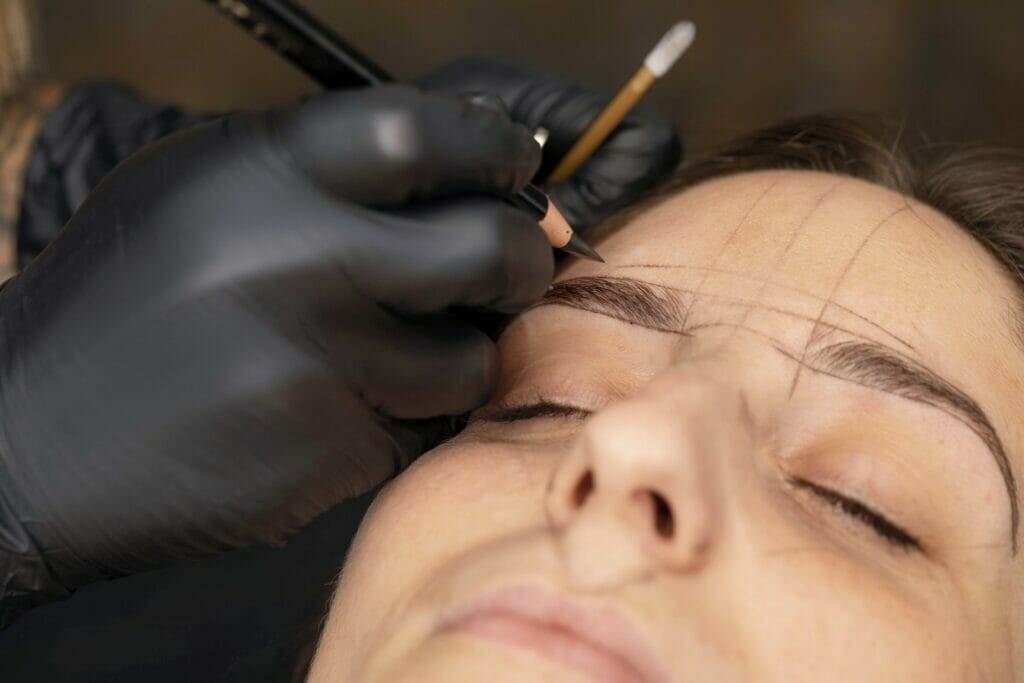
Achieving Your Dream Brows with Microblading
In conclusion, microblading is a popular and effective technique for achieving perfect brows. It offers a range of benefits, including saving time and effort in your daily makeup routine, creating a natural-looking brow, and providing long-lasting results. The microblading process involves several steps, including consultation, numbing and preparing the brow area, mapping and drawing on the brows, using the microblading technique and choosing the right pigment, and following proper aftercare instructions.
To ensure optimal results, it is important to avoid common mistakes such as over-plucking or waxing before the appointment, not following aftercare instructions, and choosing an inexperienced or unqualified microblading artist. By following these guidelines and maintaining proper aftercare, you can achieve your dream brows with microblading. So why wait? Consider microblading for perfect brows that will enhance your natural beauty and boost your confidence.

